VI.
The Cult of Learning Transfigured
This is what is best about the philosopher's mantle [pallium]: the very act of immoral thought reddens it. . . . Be glad and rejoice, o you pallium, that you now serve a better philosophy, since you clothe the Christian.
—Tertullian De pallio 6.2
When Caracalla became sole emperor in A.D. 212, his official portraiture depicted him with close-cropped hair, a crude, stubbly beard, and the fierce look of a storm trooper. It was a rather abrupt break with the noble and distinguished appearance of his predecessors, especially in rejecting the "intellectual beard" worn by every emperor since Hadrian, including his own father, Septimius Severus. This portrait signals a new conception of the emperor, probably directed primarily at the army, an image of toughness and power expressed in the language of command and obedience.[1] The rapidity with which these new visual formulas remodeled the image of the average Roman citizen might lead us to suppose that in the age of the soldier-emperors, learning and high culture lost the high status they had enjoyed as central values of Antonine society, while the ideology of virtus became once again dominant.
This is not, however, the case. Rather, the life of learning and philosophy seems to have endured with extraordinary vigor in this time of crisis. The archaeological evidence suggests that it attracted ever greater numbers and wider circles within society. In particular, the appeal of the world of the intellect seems to have become more and more sought out for its practical assistance in living one's daily life. I believe this thesis finds its strongest support in the great popularity of certain imagery in the funerary monuments of the middle class. My discussion will therefore be based primarily on the relief sarcophagi that are so plentifully preserved.
In Hadrianic and Antonine portraiture, the self-styled intellectual had been striving above all for a place of distinction in society. In this arena, however, the intellectual image was eclipsed during the age of the soldier-emperors by a new value system. But in the sphere of private introspection, that image retained its significance. Thus the patrons who commissioned the "philosopher sarcophagi" are in effect their own audience. The imagery upon the sarcophagi gives the impression of strong personal convictions, of a private acknowledgment of a certain way of life. The change of pictorial medium from portrait to sarcophagus is surely not without meaning.
As in our discussion of Antonine portraiture, I should like to try to make inferences from the monuments themselves about the generally accepted values of society. H.-I. Marrou adopted this same approach in his book Mousikos Aner . We must of necessity focus almost exclusively on the city of Rome, since only here does the relevant imagery survive on such an extensive series of sarcophagi.[2]
Learned Couples and Their Child Prodigies
A well-known fragment of a sarcophagus in the Townley Collection of the British Museum shows a seated, reading figure, dressed in Greek citizen attire, together with Thalia, the Muse of comedy (fig. 144).[3] As he reads, the right hand makes a gesture of speaking. Is he reciting verses, or is this gesture directed at the Muse? This is the same schema that had earlier been used to depict the famous poets and philosophers of the past engaged in their intellectual labors (cf fig. 74). Here, however, the reader is evidently a contemporary individual, as implied by the portrait features and the standard Late Antonine style of long beard and contemplative brow. The deceased is thus celebrated for one particular quality: his learning, or, more precisely, literary learning.
Although found in Rome, this sarcophagus was in fact produced at Dokimeion, a small town in distant Phrygia, which had a famous workshop producing column sarcophagi of the Asia Minor type. The portrait of the deceased was presumably added only after the export and sale of the sarcophagus in Rome, about A.D. 200. The same work-
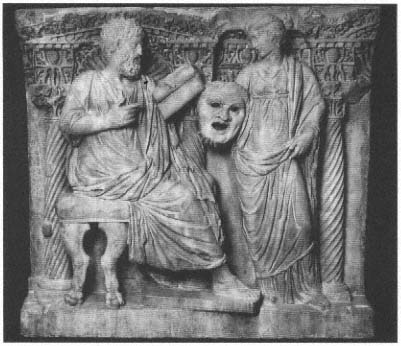
Fig. 144
Man reading, with his Muse. Fragment of a sarcophagus from Asia Minor,
ca. A.D. 200. London, British Museum.
shop also had in its repertoire other scenes of the ordinary citizen engaged in intellectual pursuits. In such scenes the spouse often sits opposite. On a more modest sarcophagus from a local workshop and now in the museum at Konya in Turkey, a man holds a book roll in his left hand and raises the right in a gesture of instruction (fig. 145).[4] Once again, as with the portraits in the ancient Greek manner, the stimulus for this imagery on sarcophagi came to Rome from the Greek East. But the imaginative adaptation of the new iconography by Roman workshops, as well as the steady increase in popularity of sarcophagi of this type into the late third century, especially the more modest ones, shows how easily the Roman patron was able to identify with the new visual imagery.[5]
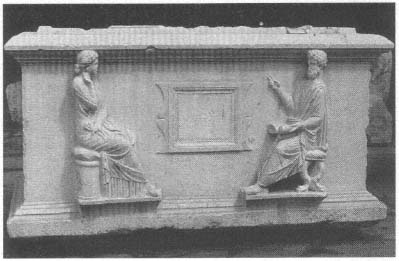
Fig. 145
Sarcophagus of a married couple, from Asia Minor. Ca. A.D. 200. Konya,
Museum.
The notion of "learning" had already been a popular theme on Roman relief sarcophagi of the Antonine period. But there it was a variety of mythological motifs, especially a gathering of the Muses, that expressed the idea in allegorical terms. The great innovation in the imagery of the column sarcophagi imported from Asia Minor was in the direct representation of the deceased as a man of intellectual pursuits in the real world of his own time. It is quite revealing, for example, that a motif like that of the Konya sarcophagus found a particularly receptive audience in Rome, celebrating as it does both the importance of family values and the dominant position of the pater-familias (though here in a new guise, as the learned teacher of literature or philosophy; fig. 146). But unlike the Asia Minor column sarcophagi, those made in Rome very seldom employ the motif of the contemplative man lost in thought. The Roman amateur intellectual prefers to show off his learning. In other words, in the Roman view, reading and study should be put to practical use. The writings of the ancients are an ever-present resource that can be pressed into service
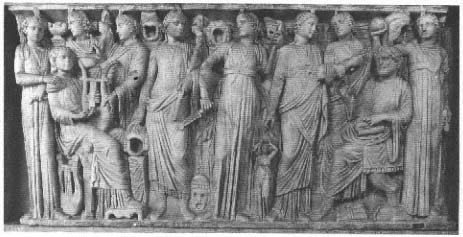
Fig. 146
Sarcophagus with a married couple before a chorus of Muses. Ca. A.D. 260. Rome,
Vatican Museums.
at any time and transmitted to the next generation. This reflects the traditional Roman attitude toward the uses of Greek literature, though it does not rule out the possibility that the teacher with his right arm raised is directing the lesson to no one so much as himself.
On Roman "philosopher sarcophagi," husband and wife often appear as a couple, a row of Muses in the background, and, at least at first glance, they seem to enjoy equal status. For the first time, at long last, we find women accorded an integral role in the commemoration of the intellect. There is, nevertheless, a clear division of roles by gender, one that may be problematical to modern sensibilities. While the man reads or reflects on his reading (in either case holding a book roll), his wife usually plays a stringed instrument, though she too may occasionally hold a book. This is undoubtedly more than just an idealized image. In the highly ritualized practice of home entertainment, women surely did offer just such musical diversion. The "fine arts" were most appropriate to the ladies, just as in upper-class society in the fast century it was the ladies who sang or played the piano for the evening's
entertainment.[6] In Rome, however, a woman's musical talents are always expressed by means of mythological allusion. That is, on the sarcophagi, women are included among the Muses. On the sarcophagi from Asia Minor, by contrast, the women appear in normal, everyday citizen dress. The Roman woman is thus differentiated from her mythical counterparts, who often appear in the background, only by her prominent position and her portrait. The analogy has a long tradition, going back to Plato, who called the poet Sappho the tenth Muse (Anth. Gr. 9.506).[7] This mythical overlay means, however, that the wife, unlike her husband, is distanced from the real world. There is thus no immediate spiritual rapport between the married couple, as had been the case on the Asia Minor sarcophagi.
The Roman amateur intellectual is often accompanied by professional philosophers, characterized as such by their traditional Greek dress and accoutrements. But unlike the relationship of the Roman matron to the Muses, these Roman men, while they may be reading or teaching, never really belong to the circle of philosophers that surrounds them, nor do they as a rule communicate directly. Indeed, no matter how deeply they immerse themselves in their reading or how passionately they teach, they are still clearly marked off from the professional philosophers around them by their fashionably Roman hair and beard styles and by their Roman dress. That is, the Greek philosophers are understood as the advisers to the educated Roman, and their constant presence underlines how seriously the deceased had cultivated a philosophical way of life.
It has been recognized since the work of Marrou that the men depicted in this intellectual guise cannot actually be those who had devoted their professional lives to scholarship, teaching, or philosophy, as some of the more impressive sarcophagi had originally led scholars to believe. The considerable number of the so-called philosopher sarcophagi alone makes this idea unlikely. But seldom do we learn what their actual profession was, as we do, for example, in the case of the centurion L. Pullius Peregrinus, who was buried in an expensive sarcophagus about the year A.D. 250 (fig. 147).[8]
This commander, a member of the equites who probably served in the Praetorian Guard in Rome, is surrounded by a lively group of
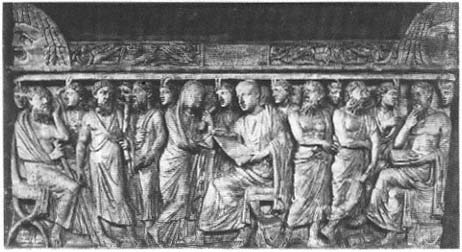
Fig. 147
Sarcophagus of the centurion L. Pullius Peregrinus and his wife. The centurion is shown
as a "wise man" with philosophers, his wife as a Muse. Ca. A.D. 250. Rome, Museo Torlonia.
philosophers engaged in discussion or solitary contemplation. They are evidently intended to represent six of the Seven Sages, with Peregrinus, the scholar-officer, Joining them as the seventh. Remarkably, all the wise men are depicted as itinerant Cynic philosophers. Their asceticism and self-sufficiency are evident in the coarse mantle, the only garment they wear over bodies toughened with age and hardship. The straggly beards and hair, indicating a lack of concern for physical appearance, the knotty staffs, traveling sacks, and the "Cynic's club" that we have seen before (fig. 143), as part of the statue of the so-called Heraclitus, all contribute to this impression. As we saw in the story of Apuleius' day in court, this "costume" was considered proof of a rigorously philosophical way of life. On our sarcophagus too, the unusual presentation of the six wise men must carry the same connotation: the officer admires these men and considers them his moral exemplars. Perhaps this may even explain the significance of his cognomen, Peregrinus ("Wandering Stranger").
This hardly means, of course, that Peregrinus actually imagined himself as an ascetic, contemptuous of the world, any more than the men depicted in comparable Antonine portraits. Indeed, his own hair and beard reflect the fashions of the day, and his finely draped, voluminous Greek mantle, the chiton underneath, and the sandals comprise a relatively substantial outfit.[9] This rather comfortable look makes a good comparison with that of the statue of Poseidippus that was reworked about the middle of the first century B.C. (fig. 110). If we may trust Tertullian, a contemporary of Peregrinus, the latter's leisure outfit, as depicted here, is perfectly authentic. While the toga continued to be reserved for public activities and obligations, the mantle (pallium ), as the Christian apologist explains, marks the relaxed ambience of the home. At the same time, according to Tertullian, this was the garment that made professional intellectuals of all kinds recognizable in public (De pallio 6.2).
On the surface, it seems not much has changed since the rituals of otium played out in the villas of the Late Republic. The difference is that for Peregrinus learning is no longer a casual occupation for his leisure hours, but rather, as implied by the presence of his ascetic philosopher friends, a means to his goal of a philosophically oriented lifestyle.[10] The evocation of the Seven Sages need not surprise us. Their wise sayings probably served Peregrinus as a valuable guide to life, just as did the rules of behavior taught by the philosophers. Philosophy is here understood as the art of life, as we find it also in the Meditations of the emperor Marcus Aurelius. This included the ideal of asceticism, however it might be practiced (cf. p. 242). Thus the men surrounding Peregrinus, characterized as wandering Cynic philosophers, may convey the same basic idea as the unkempt and filthy hair of an Apuleius and his cronies, that is, a declaration of loyalty to a rigorously philosophical way of life. Borrowing from an analogous Christian practice, one could speak here of a "philosophical succession."[11]
Meanwhile, Peregrinus' wife, in the context of his grandiose funerary rhetoric, enjoys the accustomed likeness to a Muse, but in a carefully chosen manner. She is immortalized in the pose of Polyhymnia, and, instead of joining her sisters in the background, she is positioned
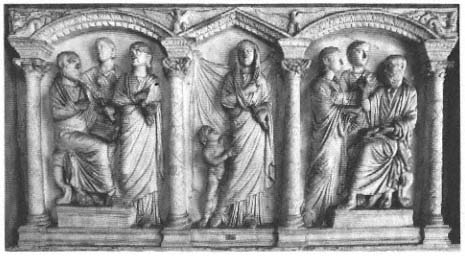
Fig. 148
Sarcophagus with dual representation of the head of the family. Ca. A.D. 240. Rome,
Vatican Museums.
directly opposite her husband. This confers an added dimension on the conventional Muse comparison, as the wife takes on the role of her husband's personal Muse. The traditional grouping of a poet or philosopher and the Muse who inspires him (cf. figs. 74, 144) is here assimilated to the notion of marital concordia in the shared service of the Muses. Following her own death, the wife would have her portrait carved in the style of the period, so the sculptor has left her head incompletely worked.
The intellectual and musical activities portrayed on these sarcophagi are generally tied to a familial setting. On one of the big, impressive sarcophagi in the Belvedere of the Vatican, a family man, whose portrait could easily be mistaken for that of the emperor Pupienus (A.D. 238), is shown along with his wife and several daughters (the scene continues onto the short sides), who constitute the chorus of Muses.[12] Remarkably, the father appears twice, both times in the guise of the intellectual (fig. 148). It is unlikely that such a striking
repetition was done only for the sake of symmetry. Presumably the two slightly different images are intended to divide the praise of learning into two categories, the philosophical and the rhetorical, as we have already noted in the case of the burial chamber of C. Valerius Hermia under St. Peter's (cf. fig. 139). On our sarcophagus, the deceased is portrayed in the left-hand scene with the mantle wrapped tightly, thus enveloping the right arm in the Classical manner. Even here, well into the High Empire, this pose could still connote an orator, even if that hardly suits the domestic setting. On the right side, by contrast, he is depicted as a teacher. The conception of learning is once again meant to be as all-embracing as possible.
The praise of education is often extended to the children as well, especially to the boys. Just as the little boys on mythological sarcophagi may be shown in the role of keen hunters, to signal their future virtus, so elsewhere the parents commemorate their precocious little scholar, particularly in the guise of the passionate orator. On a child sarcophagus in the Vatican, for example, a boy lectures to a group of his playmates decked out in the attributes of the Muses (fig. 149).[13] The conventional relationship of the Muses to the man of learning is here both elaborated and turned upside down. It is not the Muses who inspire the little professor, but the other way 'round. Clio records the precious words of the wunderkind. But in order to make the scene halfway plausible, the artist has transformed the Muses into little contemporaries of the deceased. The serious purpose of commemorating the dead still admits an element of playfulness.
The same boy appears a second time, on the lid. He is accompanied now by his favorite puppy but otherwise is fully devoted to his studies. This apple of his parents' eye holds in one hand an open book roll (the hand with the book roll is a modern restoration). In front of him lies an open polyptych for taking copious notes. The motif of the precocious child intellectual, which we shall encounter again in connection with the iconography of Christ, is one that was popular throughout the Principate. But the numbers of both the carved scenes and the corresponding grave epigrams increase dramatically in the later third century.[14]
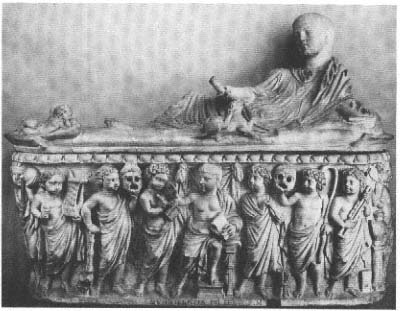
Fig. 149
Sarcophagus of an intellectual wunderkind, who instructs the "Muses" in
the guise of boys his own age. Ca. A.D. 280. Rome, Vatican Museums.
Political Office and the Philosophical Life
Despite the familial focus of most of this imagery, some of the more elaborate sarcophagi of the later third century do illustrate the public recognition and auctoritas that come to the educated man who has led his life following the precepts of the philosophers. On a fragment of a huge and splendid sarcophagus in the Vatican that was once wrongly associated with the philosopher Plotinus, the figure of a philosophical layman is "enthroned" frontally before the viewer, not unlike a magistrate presiding at court (fig. 150). He pauses in his reading and looks pensively into the distance. The pile of book rolls at his feet alludes to his devotion to his intellectual pursuits. Two women belonging to his
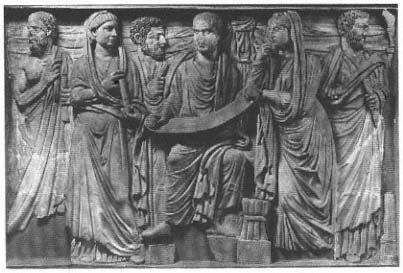
Fig. 150
Fragment of a lavish sarcophagus ca. A.D. 280, showing an amateur philosopher
surrounded by Muses and philosophers. Rome, Vatican Museums.
family—both have portrait features and wear hairstyles of the period—stand beside him and look on admiringly.
Like Peregrinus, the deceased was surrounded by a group of philosophers, though the fragment preserves only three. But unlike Peregrinus' itinerant Cynics, these belong to a more presentable breed. In addition, the sculptor has taken pains to differentiate their outward appearances. Thus one wears a long undergarment, while a second, whose balding head recalls Socrates, wears only a mantle, and the third, who is distinguished from his well-tended colleagues by his wild hair and beard, nevertheless wears his mantle properly draped. It would seem that they are meant to be representatives of different philosophical schools, and all served as advisers to the deceased. But the one with wild hair, who stands beside and addresses him, seems the most trusted, probably his closest confidant. The arrangement of the figures makes clear the hierarchy within the ranks of the counselors. An encyclopedic education is the prerequisite for the philosophical life, but
in the end what matters most is adherence to a moral standard, which can be achieved only through constant spiritual exercise and the help of a role model whose own life admits no compromise.
Intellectual superiority is presented here as the highest form of auctoritas, expressed in the frontal image borrowed from Imperial state monuments. And yet this is once again not a professional intellectual, but rather, like Peregrinus, a layman or, as Marrou says, an "amateur." The style of his shoes (calcei ) may suggest his identity as a member of the equestrian order.[15] Although we have thus far considered only sarcophagi whose imagery is confined to the private and domestic sphere, there are other examples from the time of the emperor Gallienus (A.D. 260–268) and later that make clear the direct connection between intellectual pursuits and political office. The prestige of learning acquired through rigorous philosophical training had now apparently grown to the point where even men of consular rank considered this an integral element of their identity and not merely a convenient status symbol. In the time of Marcus Aurelius, by contrast, these same Roman aristocrats had used traditional imagery to celebrate their virtus and their qualities of military leadership, especially on the battle or "Feldherrn" sarcophagi.[16] Yet this is the same period in which we saw evidence for the high valuation of learning in the Zeitgesicht and the fashion for long beards.
The so-called Brother Sarcophagus in Naples presents four versions of the same deceased individual, probably a Roman senator, in different outfits and poses, in contiguous scenes (fig. 151).[17] That it is the same man is clear because his portrait features remain the same. The whole image is thus a kind of "gallery" of the type sometimes partially preserved in the form of busts or statues and attested in written sources for the emperors themselves.[18] So, for example, a painting in the palace of the Quinctilii depicted the emperor Tacitus (A.D. 275–276) in five variations, as togatus, chlamydatus, armatus, palliatus, and venatorio habitu (Hist. Aug., Vopisc. Tac. 16)—that is, in a toga, in a military "traveling outfit," in a cuirass, in the Greek mantle, and in hunting costume. The picture sounds like the visualization of one of those particularly verbose honorific inscriptions. Similarly, the Naples sar-
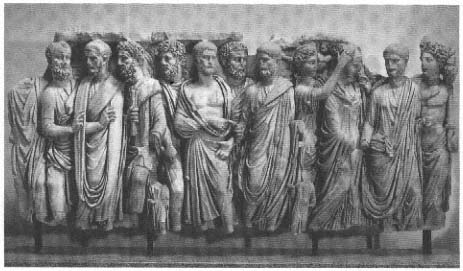
Fig. 151
So-called Brother Sarcophagus, showing the deceased in various
"roles." After A.D. 260. Naples, Museo Nazionale.
cophagus celebrates in turn each of the most important virtues or spheres of activity of a senator or other high official. At the left we see him at the acme of his political career, assuming office, while at the far right his marriage is shown. Thus his exemplary private life is presented as the counterpart to his political career. In the center, however, he is shown once in the guise of the ascetic Greek philosopher, wearing only the himation, and once as a Roman wearing a toga. The two seem as if in conversation, but this of course is not to be taken literally. Rather, the pairing expresses the inextricably linked dual identity of the Roman aristocrat, comprised, in equal measure, of the precepts of philosophy and the traditional values of the mores maiorum —however the boundary between these two may have been defined. In his guise "Roman," the honorand wears a simple toga. The little attendant next to him alludes to that most important of the old Roman virtues, religious piety.
The Brother Sarcophagus is far from unique. There are other,
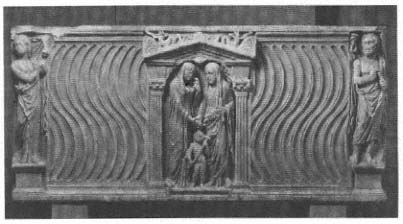
Fig. 152
Sarcophagus of married couple. In the middle they share in a sacrifice; in
the corners, he is shown as a philosopher, she as a Muse. Second half
of the third century A.D. Munich, Glyptothek.
less extravagant sarcophagi that show the deceased both in ail old-fashioned toga and in the pallium, or as a public official wearing the toga contabulata, along with his philosopher-advisers. A good example is an unusually large strigilated sarcophagus in the Glyptothek in Munich, Severan in date (fig. 152).[19] Here again a married couple appears in two different guises. The scene in the middle celebrates their marital concordia, while the figures in the corners allude to literary, philosophical, and musical education. The husband gestures toward his book roll as if to make a point; his wife, in the pose of Urania, points to a globe (sphaira ) that was originally held in her left hand. As on other sarcophagi of this type, both individuals are elevated on pedestals. In this way a connotation of "public honors" is evoked to enhance the praise of the dead.
These are important monuments in the history of Roman intellectual imagery. The pallium now enjoys a status equal to that of the toga in the catalogue of virtues prescribed for the Roman aristocracy and even the emperor. We may recall that among the five images of the
emperor Tacitus was one wearing this type of Greek mantle (palliatus ). What was once a leisure pastime with dubious moral connotations has now become an indispensable prerequisite for the man of public affairs. As is well known, in the Late Empire, a good education, including philosophy, became an important criterion in the recruiting of high officials in the imperial bureaucracy and, just as at one time the withdrawal into a world of intellectual otium, it was also a kind of status symbol.[20] The extraordinary value for the historian of the visual evidence lies in demonstrating to what extent these criteria were, by the second half of the third century, firmly established within the value system of urban Roman society.
The number of splendid sarcophagi of high artistic achievement, of the type we have been looking at, is of course relatively small. But at the same time a large class of simpler, so-called strigilated sarcophagi gives evidence of how widespread the same kind of self-image had become among broad strata of the prosperous "middle class" in the city of Rome, those who could afford a marble sarcophagus in the first place (fig. 153). Even among those of modest artistic pretensions, the majority at least allude to the intellectual pursuits of the deceased in the form of a book roll. Generally the front side of the sarcophagus is decorated with three small scenes in relief, in the middle and at the ends, the remainder filled with the ripple pattern. The scenes repeat the visual program of the larger sarcophagi, only reduced to a set of shorthand slogans. The same is true of the widespread integration of these scenes amid other kinds of imagery, in particular of shepherds in a bucolic setting. Often the deceased couple stands or sits opposite one another at the two corners in the traditional roles of philosopher and Muse (or, later on, as praying figures: orans ), as on the fine sarcophagus in Munich (fig. 152). The husband almost always wears the more ascetic kind of philosopher's mantle, without an undergarment. He is no longer afraid of identifying himself fully with his role model. A striking motif in the middle panel of some examples is of a professional philosopher, either reading alongside a Muse or engaged in conversation with a colleague. The long hair of some of these men recalls the
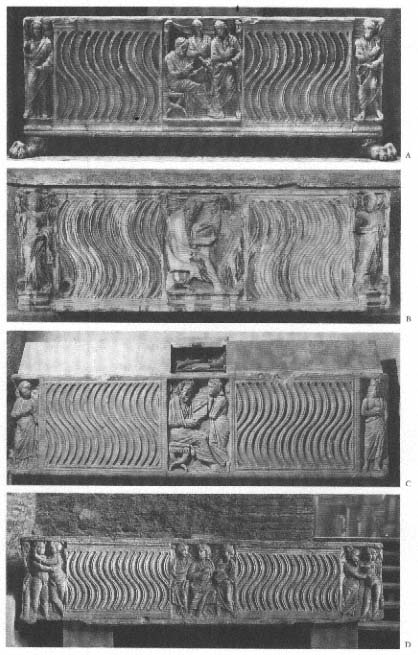
Fig. 153
Four modest strigilated sarcophagi showing the deceased either in the guise
of a philosopher or as a Muse. Second half of the third century A.D. a) Florence,
formerly on the Ponte Vecchio. b) Pisa, Campo Santo. c) Porto Torres (Sardinia).
d) Rome, Museodelle Terme. (Wegner 1966, nos. 31, 79, 81, 127.)
Charismatic philosophers, the "holy men" whom we heard about in the previous chapter and will shortly encounter again in our discussion of the image of Christ. In abbreviated form they carry the same message as the circle of ascetic philosophers around Peregrinus or the philosophical friends of "Plotinus," only the feeling of reverence for philosophical instruction is even more clearly articulated.[21]
There are only two themes that can rival the popularity of the Muses and intellectual imagery on sarcophagi of the later third century: hunting, which was the traditional symbol of strength, courage, and valor, and the bucolic shepherds. But it is also significant that the "philosophers" now often take over the pastoral setting, and on one of the more magnificent sarcophagi the tried and true symbol of virtus is actually relegated to the back side, while the front is given over to the philosophers.[22]
The Educated Man's Search for Inner Peace
A remarkable change can be detected in the iconography of sarcophagi in the course of the second half of the third century, especially those with bucolic scenes. Whereas the amateur intellectual had previously often appeared as the zealous teacher, we now have the impression that the teaching is directed only at himself. At the same time, the earlier domestic scenes are transported to a bucolic setting in the country. One of the earliest examples, probably not much later than A.D. 250, is a recently published sarcophagus in Basel (fig. 154).[23]
The deceased couple each appear twice with portrait features: once in the central portrait medallion as a proper married couple, the husband wearing the official magistrate's toga, and again in the landscape scene, in which each personifies the values they cherish. He sits in a marble seat, holding a curved staff, and wears only the mantle that marks him as a philosopher or poet. Unlike Peregrinus, he wears no undergarment and has attributes that would suit an itinerant philosopher, yet he is definitely a layman. Despite the poor state of preservation, one can make out that the head bears portrait features and is beardless. Thus, as on other sarcophagi, he must be read as a pendant
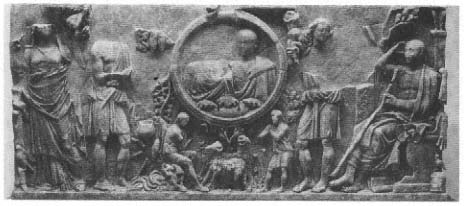
Fig. 154
Sarcophagus of a married couple with bucolic figures. After the middle of
the third century A.D. Basel, Antikenmuseum.
to his wife, the woman in the orans pose, who likewise had portrait features.[24]
This amateur intellectual has interrupted his reading (the open book roll lies on the ground where he dropped it) and sits lost in thought. This is expressed, however, in a visual motif that is thus far unique. He holds his head high and raises one hand to his brow, as if he were looking out into the distance, or as if he were having a vision. On either side of the medallion stand a man carrying a sheep and a fisherman, while below, on a smaller scale, are two shepherds with their flock. All these bucolic elements have a long pictorial and literary tradition and would have been familiar to the contemporary viewer as symbols of the happy life.[25] The message seems to be that intellectual pursuits and the rural life confer on the individual a happiness and peace of mind comparable to that of the carefree shepherd. This is made even clearer by two complementary scenes on the short sides of the sarcophagus. In one, two philosophers, dressed as the seated figure on the front, engage in conversation, while, in the other, a herdsman pastures his sheep. On the one hand, the "philosopher" is assimilated to this bucolic world through his knotty staff and animal hide, while, on the
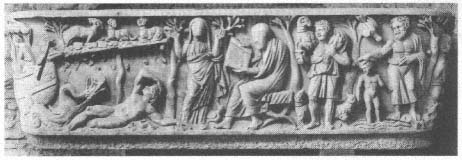
Fig. 155
Sarcophagus of a married couple with bucolic and biblical scenes. Late third century
A.D. Rome, Santa Maria Antiqua.
other, his carefully arranged garment and the various props (the marble seat, sundial, vine-covered pillar, and bookcase) tie him firmly to the well-tended villa where he devotes himself to his studies.
Along with the infiltration of these bucolic motifs into the world of the amateur intellectual comes frequently a changing imagery for women. The Basel sarcophagus, like others of the later third century, depicts the wife as an orans, with both arms raised. Comparison with images on coins prove that this is a symbol for piety (pietas ). The Muse has become a woman of prayer. This too, however, is a role for women that is well established in the traditions of Roman art. Julio-Claudian princesses, for example, had sometimes been shown in the same position of prayer.
Learning and the life of the mind are now presented as assisting in the search to attain inner peace and happiness. One of the earliest Christian sarcophagi, in Santa Maria Antiqua at the Roman Forum, illustrates this especially vividly (fig. 155).[26] The reader-philosopher sits in the open air beside his praying wife, framed by a man carrying a sheep and the figure of the prophet Jonah reclining under a bower (a popular image in catacomb paintings, which does not correspond to the biblical tale of Jonah but was first created in this period as a Christian version of the bucolic idyll). The baptism scene at the right edge, along with the figure of Jonah, identifies the context here as a Chris-
tian one. Hence the reading figure in the middle is most likely not studying the classics, but rather Scripture. In contrast to earlier imagery, the reader is now devoid of any ostentation. He is completely oblivious of the world around him.[27] Reading itself has become a pious activity and there is no fundamental difference between the husband's devotional reading and his wife's prayer. This is particularly well illustrated on a sarcophagus relief in the Museo Civico at Velletri.[28] The deceased woman stands in the orans pose in the center, flanked at either side by a shepherd. The space in between is filled with a patchwork of small-scale scenes from the Old and New Testaments. In one of these little scenes, right next to the orans, a philosopher sits beside a chest filled with book rolls and reads. Thus a chain of associations is created between the reading of the Scriptures, faith and prayer, and the happy condition that these lead to. The direct connection between reading and praying figures must be deliberate; it implies that the whole character of intellectual activity has changed.
Beginning in the later third century, the question was hotly debated in philosophical circles whether the wise man should withdraw from public life entirely or only on occasion, whether by means of a kind of "inner escape" within the city (there were some philosophers who no longer went out of the house) or by moving out to the country. The notion itself was not new. In the Flavian period, the Stoic philosopher Musonius Rufus had explicitly recommended the life of a peasant or shepherd to the philosophically inclined individual: "And if the tending of the flocks did Hesiod no dishonor, nor did it prevent the gods and the Muses from loving him, then neither should it anyone else. For me this is the most agreeable of all rural activities, for it offers the soul the greatest opportunities for leisure and reflection, and for the pursuit of everything we mean by paideia ."[29]
Now, however, this association between the philosopher and the pastoral life came to be seen as so desirable that it is not unusual to find a well-dressed wise man actually tending a flock of sheep or, conversely, conventional shepherds depicted with the pose and facial expression of an intellectual.[30] The very fact that such motifs were adopted so naturally into the pictorial vocabulary shows that these
metaphors for spiritual longing must have been firmly fixed in the minds of many people outside the narrow philosophical circles.
But whereas the real philosophers and, soon after, the first of the Christian hermits longed for isolated spots devoid of human contact, the amateur intellectual generally appears in scenes where he is well integrated into the life of a country estate. So, for example, the landowner might be shown on sarcophagi reading, his wife at prayer, in the midst of scenes of vintaging, the olive harvest, hunting, or a country meal. A large mosaic from a villa at Arroniz (Navarra) shows several men in contemporary dress, probably large landowners, as literati accompanied by their Muses, each against the backdrop of a villa setting. And a North African mosaic combines a bucolic scene with a villa garden and clearly labels the whole ensemble as filoso[fi?] filolocus .[31]
Naturally the age-old Roman tradition of otium and the continuing attraction of villa culture played an important role in all this.[32] But it is not enough to describe this phenomenon as simply a revival of the old idea of otium . At least in the case of some of the Neoplatonists and their followers, we are now dealing with an escape from "the world." The principal goal is to avoid any kind of disturbance so that one may focus on the interior life, tranquility of the spirit, and the search for God.[33] But even for the landowner, the path from Rome to one's country house becomes a symbolic journey into the world of the spirit. As a series of scenes on sarcophagus lids of the early fourth century illustrates, reading and discussion might begin already in the car on the journey out (fig. 156).[34]
In the time of Constantine, Aidesios of Cappadocia, a pupil of the famous Iamblichus, consulted a mystic oracle and was given a choice between a life of "undying fame" in the cities or one as a shepherd or cowherd "with the hope of union with the immortal gods," that is, a divine revelation. (Musonius, we recall, had spoken only of the search "for everything we mean by paideia .") Aidesios did actually acquire a small farmstead in the mountains of Cappadocia, but it was not long before his own pupils could persuade him to return to the philosophical schools. In the opinion of Eunapius, who records the story (VS 465), this was not the better course. It is only against the background of such hopes for divine revelation through isolation from the
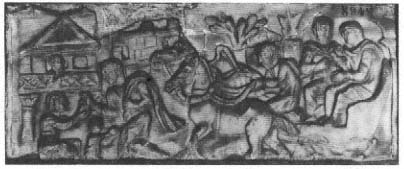
Fig. 156
Fragment of the lid of a large sarcophagus, showing a man and his wife in
conversation on the way to their villa. Ca. A.D. 280. Rome, Terme Museum.
world that we can grasp the full significance of the visionary gestures of the "philosopher" on the Basel sarcophagus or the many orans figures directing their admonition straight at the viewer.
Christ as the Teacher of the True Philosophy
He who would observe the image of God in earthly colors, on the grounds of His having become a man, let him be accursed!
—Bishop Epiphanius of Cyprus (ca. A.D. 400)
With the official recognition of Christianity, sculptors' and painters' workshops in Rome were quick to respond to the changing wishes of their clientele.[35] Traditional imagery, especially drawn from mythology, becomes rare, and a new Christian iconography suddenly takes its place. Bucolic symbolism of peace and happiness is replaced by scenes of miracles, and Christ, the teacher of wisdom, takes the place of the cultivated Roman citizen. The fundamental moral objection to visual imagery on the part of the bishops and church fathers
was evidently outweighed by the layman's powerful need to evoke the new message of salvation in physical form.[36] For our purposes, two aspects of this phenomenon are of particular interest: the remarkable continuity of the imagery and, at the same time, the sharpening of the hierarchical dichotomy between master and pupil.[37] Christ himself, the apostles, prophets, and saints are all depicted like pagan intellectuals. As a rule then, wear the Greek mantle (pallium ) with undergarment and hold a book roll in one hand—even when this seems rather an impediment in certain scenes of miracles.
But it was not through the medium of visual imagery alone that the Christians set themselves firmly in the tradition of the pagan cult of learning. They also assimilated themselves to it in their daily lives. Tertullian first declares the pallium to be the suitable garment for a Christian (De pallio 6). In the Eastern provinces, this would not have been noticeable, but in the West it meant the adoption of distinctively intellectual dress. In addition, from the third century on, church fathers recommend the wearing of a beard. Clement of Alexandria, for example, writes in favor of the beard on the grounds that it gives a man a dignified and awe-inspiring appearance (Paid. 3.11.60). Sometimes the beard is justified on moral grounds, just as earlier the Stoics had done. Augustine writes: "Barba significat fortes, barba significat iuvenes, strenuos, impigros, alacres" (Enar. in psalm. 132 [Migne 37.1733]).[38] Thus Christians who followed this advice on dress and appearance would have taken on the traditional image of the philosopher. This was presumably true above all for the clergy. On the Carrand Diptych of ca. 400 (cf. fig. 161), the apostle Paul and his pupils appear in conventional philosopher dress. This evidently reflects the styles worn by the clergy in this period, since the imperial magistrate and his entourage on the same diptych also wear the official outfits current at the time.[39]
But when there was a need to fashion the very essence of Christ into a single visual image, he was depicted exclusively as the teacher of wisdom starting in the later third century, both in catacomb paintings and on sarcophagi.[40] The usual pose was seated frontally facing the viewer, which had already been used on earlier sarcophagi and was
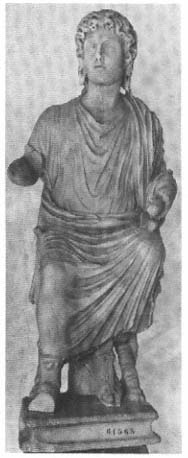
Fig. 157
Christ teaching, from a column sarcophagus (?).
Ca. A.D. 380. Rome, Terme Museum.
derived from the magistrates in Roman state art. Even earlier, professional teachers had been depicted in this pose of authority (cf. fig. 126). The typological similarity is particularly striking when we compare images of Christ with the "child intellectuals" of Roman funerary art, for example, the youthful statuette of Christ in the Terme Museum in Rome (fig. 157) with a child sarcophagus in the Louvre or the funerary
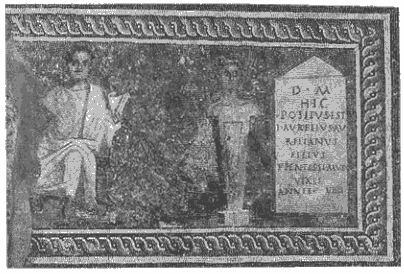
Fig. 158
Funerary mosaic for the nine-year-old T. Aurelius Aurelianus.
Third century A.D. Split, Archaeological Museum.
mosaic for a nine-year-old boy in the museum at Split (fig. 158).[41] These wunderkinder, chosen at random, match the image of Christ as teacher in pose, gestures, and drapery. Indeed, the so-called statuette of Christ might actually be a fragment from one of the sarcophagi showing scenes of instruction that has been reworked into a statuette by the modern restorer.[42] Thus Christ appears in a pictorial formula that would have been generally familiar and thereby embodies precisely the same qualities that had long enjoyed such high status in the self-image of the ordinary Roman: learning and a philosophical orientation in life. To non-Christians, these pictures of the new teacher of wisdom offered a familiar image as well. In this respect they were well suited to make Christ's teachings appear to be the continuation of a long tradition, one that was trusted and revered.
But whereas the amateur intellectuals of earlier funerary art had been shown accompanied by Muses, philosophical counselors, and
family members, Christ now sits closely surrounded by his disciples, who are also depicted frontally. The pictorial image of the teacher is set within a different context, a kind of public gathering instead of the domestic ambience. Christ invariably holds either a book roll or a codex in his left hand. He does not actually read but rather proclaims his teachings contained therein. On the sarcophagus of Bishop Concordius of Arles (d. 374), the opened codex bears the words dominos legem dat (fig. 159a, b).[43] Often the apostles have opened rolls or books in their hands as well, and they sometimes converse among themselves. At first glance such scenes are reminiscent of earlier gatherings of philosophers, as, for example, on a small mosaic of the Early Imperial period (fig. 160).[44] But while these scenes are composed of several smaller, fragmented groupings, the strict symmetry of the Christian scenes expresses in visual terms the notions of consensus and absolute devotion. The Lex Christi is hailed as the "new philosophy," a metaphor employed as early as Saint Justin and the Alexandrian apologists about A.D. 200. At the same time, however, it is made clear that there is no longer an alternative to this "philosophy."
The motif of frontality had first appeared on "philosopher sarcophagi" of the second half of the third century, but in those scenes the accompanying figures were still turned toward the deceased whose learning they acknowledge. In Christian imagery, however, the viewer is directly confronted by the whole gathering, which gives these scenes an immediacy unknown up to this time. The viewer is drawn into the group receiving instruction, yet at the same time distanced by a sense of awe. If the hypothesis is correct that among the prototypes of the large-scale catacomb paintings and relief sarcophagi were imposing frescoes or mosaics in the apses of Constantinian basilicas, this would only confirm the consciously religious function of the frontal image. We must also keep in mind that the mosaic in the apse was reenacted, as it were, in ritual, whenever, during the service, the bishop and his circle of clergymen took their places on the big bench of the exedra beneath the apse. In this way the bishop drew his authority directly from that of Christ, the teacher of wisdom, and his apostles. We shall return once more to the hierarchical structure of these images.
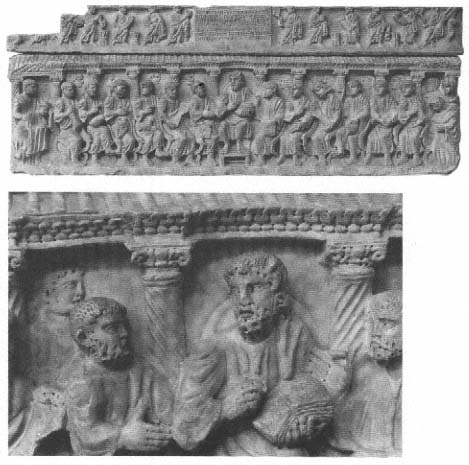
Fig. 159 a–b
Sarcophagus of Bishop Concordius. Last quarter of the fourth century A.D.
Arles, Musée d'Art Chrétien.
Iconographical formulas are stereotyped images, the vehicles that convey ideas and values. The artist who employs an old formula for a new idea fixes that idea in a specific form, one that carries with it all the connotations still attached to the formula from its earlier use. In so doing, he also, consciously or unconsciously, excludes alternative as-
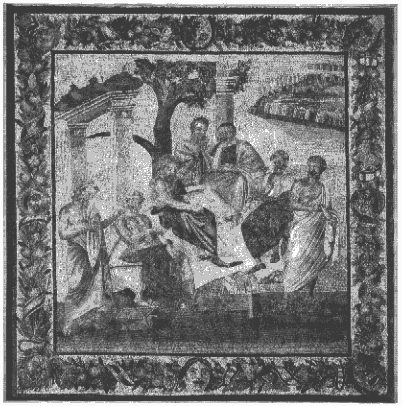
Fig. 160
Mosaic front Pompeii with a gathering of philosophers. First century B.C.
Naples, Museo Nazionale.
sociations that conceivably are integral parts of the new idea. He may, that is, alter the very character of the idea.
That Christ should appear in the image of the philosopher-teacher was anything but obvious and certainly not so ordained by Scripture. Seeing a youthful Christ in the schema of the intellectual wunderkind, the Christian viewer may naturally have thought of his appearance before the Doctors, while the bearded Christ would have reminded them of the Sermon on the Mount. But the scenes of his
teaching a group of disciples are not tailored to a specific event in the life of Jesus (with the exception of the scene on polychrome plaques, fig. 162), which would have been easy to do through the addition of the appropriate subsidiary figures. For this reason the likeness to the philosopher-teacher achieves its full effect.
The metaphor of Christ as philosopher amid a learned gathering, however, represented a distortion of what was new and distinctive about Christian doctrine, for Christianity, despite its gradual penetration into the upper strata of society, always wanted to remain the religion of the common people. Christ's message of salvation was directed explicitly at slaves as well as free people, poor as well as rich, uneducated and learned. The apostles themselves had been simple people, and Justin Martyr celebrates Jesus specifically as a carpenter. But the men in these early images come across exclusively as educated and upper class. With the adoption of the earlier iconography of the intellectual, the entire "cultural milieu" of the cult of learning, as Marrou called it, permeates the visual image. The tradition must have been so strong that even the Christians could not envisage their savior in any way other than as the familiar teacher of wisdom. This is yet a further, retrospective corroboration of how thoroughly the cult of learning had penetrated the popular mentality. At the same time, the widespread use of the motif of Christ teaching his disciples on the tombs of average middle-class citizens shows that the concept of Christianity as the "true philosophy," a metaphor originally claimed by the learned apologists in their debate with the pagans, had by at least the early fourth century become current and fully accepted by the Christian populace. These images provide powerful testimony in favor of the controversial thesis, first formulated by Adolf von Harnack, of the "Hellenization" of Christianity. Usually what is meant by this is the assimilation into Christian theology of the terminology and thought patterns of earlier philosophers.[45] The visual imagery illustrates in addition a belief, widespread among the faithful, in Christ as above all a great teacher.
These scenes of highly cultivated apostles with their philosopher-teacher raise yet another issue. The Christians were constantly looked down on as uneducated and subjected to the resulting social discrimination at the hands of the wealthy and educated classes, precisely be-
cause the new religion had had its initial success primarily among the poor. Christian apologists were always trying in vain to counter this prejudice. In this light, the imagery of the cultivated gathering of learned men may be seen as a response to these charges. These formulaic scenes functioned at several levels, directed both at the Christian community and outside it.[46]
The close association between miracles and the gospel of salvation reveals a similar dependence on traditional beliefs. As is well known, the iconography of Early Christian art is based largely on the depiction of certain miracles, and these are the very ones ascribed to the pagan "holy men." The great example is once again Apollonius of Tyana, who is credited in Philostratus' biography with healing the sick, driving away demons, out-of-body experiences, and even raising the dead. There are similar accounts in Eunapius' Lives of the Philosophers, recorded about A.D. 390. In both the pagan and the Christian context, the miracles serve to lend credibility to the teachings, as well as to demonstrate the holiness of the teacher. The scenes of Paul on the Carrand Diptych mentioned earlier are a good example (fig. 161a). The apostle teaches in the same pose as Christ, except that he does not face the viewer. The narrative is confined within the scene, where two pupils, also portrayed as philosophers or scholars, devotedly listen to his words. As with both Christ and the pagan "holy men," the authority of Paul's teachings derives from his superhuman powers, which are evoked in two additional scenes. In the central panel, the miracle of the viper on Malta is narrated and, at the same time, substantiated by the secular authority of a magistrate. Below, a crowd seeking salvation presses toward the miracle worker. At the same time, however, Paul's teaching is also seen to derive directly from God by means of the likeness to Adam, who is shown in Paradise at the right side of the image.[47]
The Dual Face of Christ
One of the most remarkable features of Early Christian art is the dual imago Christi . Christ is depicted both as a radiant youth or boy and—
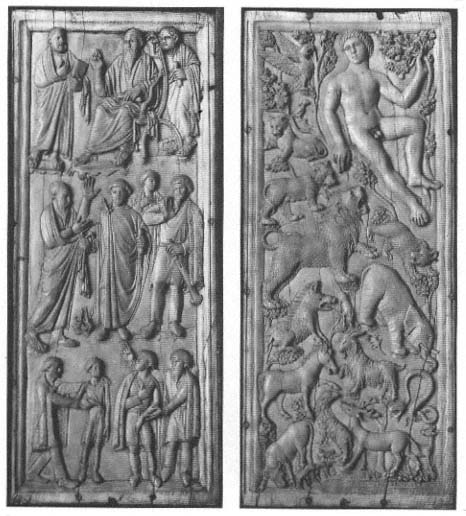
Fig. 161
Ivory diptych showing Paul as teacher and miracle worker and Adam in Paradise.
Ca. A.D. 400. Florence, Bargello.
though much less often at first—with a full beard and shoulder-length hair. Both portrait types can be used in scenes of the same subject, even many times on the same monument, yet no straightforward differentiation in meaning can be discerned.[48] Evidently there was no single, all-embracing image for the figure of Christ in the traditional vocabulary that was considered adequate. Perhaps, then, we should interpret the deliberate juxtaposition of both types as an attempt to capture the totality of Christ's nature through an accumulative process. The phenomenon is of particular interest for our investigation because both portrait types ultimately go back to ideas and pictorial models from the pagan cult of learning.
Let us consider first the youthful Christ. The picture of Christ given by Justin, Tertullian, and Clement of Alexandria is still unremarkable, and it is only in the course of the third century that the image of the beautiful youth appears, probably first among the Gnostics.[49] This is surely an instance of "Hellenization." In the scholarly literature the radiant youth has often been identified with Apollo, but this does not provide a concrete iconographical link, since Apollo's beauty is best revealed in his nude body. Rather, we may recall the tradition of romanticized portraits of young men with long hair of the second century A.D. , which conjured up various Greek heroes from Achilles to Alexander the Great as a kind of nostalgic expression of faith in the revival and preservation of classical culture (cf. fig. 157). Other idealized images of the youth with beautiful long hair may have had an influence as well, such as the Genius Populi Romani .[50] Along with the long-haired youth, we also find not infrequently an even younger, almost childlike image of Christ, not only in some of the more modest catacomb paintings, but also on some especially fine sarcophagi. This is surely somehow related to the type of the intellectual wunderkind, which, as we have seen, was especially popular in Roman funerary art of the later third century (fig. 149). Philostratus and Eunapius also, incidentally, regularly report that the charismatic wise men had been wunderkinder too, distinguished both by their spiritual powers and by extraordinary beauty.
This widespread enthusiasm for the intellectual wunderkind, which only increased as the Empire wore on, represents a definitive break
with the traditions of Greece, where mental powers and wisdom were always associated with advancing age. We are now confronted instead with the notion of a new and miraculous kind of wisdom, something one is born with, a gift, no longer the result of either great mental effort or experience. When these idealized notions of the miracle worker are adopted for the image of Christ, they take on an added dimension. This divine youth, the Son of God, stands for an all-encompassing hope for a new world.
The type of the bearded Christ, on the other hand, has always been recognized as inspired by philosopher iconography. A different avenue of interpretation, which seeks to establish a link to the Classical iconography of the Greek gods, whether Zeus or, as more recently suggested, Asklepios, has rightly found little favor.[51] Nevertheless, I believe it is one particular tradition of philosopher iconography with which we are dealing. His shoulder-length hair clearly separates the bearded Christ from the philosopher portraits of Classical and Hellenistic art and places him instead in another tradition, one that we first encountered in the description of Euphrates (cf. p. 257). As I have tried to demonstrate, this type of portrait, or, rather, the self-image that lies behind it, was meant to translate into visual terms a special aura of dignity, as well as magical and spiritual powers to which these "holy men" lay claim. Of all the guises in which intellectuals of the past had appeared, this one radiated the ultimate authority. Although it has proved impossible to arrive at a clearly defined prototype, both because literary descriptions are vague and contradictory and because the visual evidence from the second century is still rather spotty, I nevertheless remain convinced that the image of the bearded Christ with shoulder-length hair is closely associated with that of the theios aner . The comparison of Christ with the pagan miracle workers, who likewise possessed divine powers and, in their own way, also promised a kind of "salvation," was self-evident and became a favorite topos in the debate between pagans and Christians. It is in the portraiture of the later Charismatic philosophers, who were believed even more "holy" and "divine," that we shall once again encounter the type with shoulder-length hair.
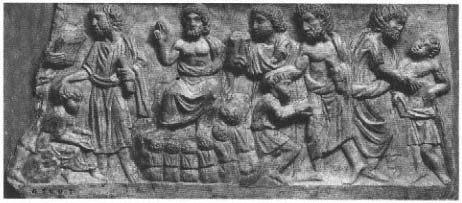
Fig. 162
So-called polychrome plaques, showing Christ performing miracles and at the Sermon
on the Mount. Ca. A.D. 300. Rome, Terme Museum.
The first secure example of a bearded Christ belonging to this tradition is on the "polychrome plaques" made in Rome about A.D. 300 (fig. 162). But there must have been earlier examples, as we can infer from references to the images of Christ of the Karpokratians, who used these as objects of cult worship, along with portraits of Plato, Aristotle, Pythagoras, and others.[52] Christ appears in several scenes on the polychrome plaques as healer or miracle worker, sometimes still depicted as an ascetic philosopher with no undergarment, similar to the figure of the itinerant philosopher in the Herakleion Museum that we saw earlier (fig. 143). In one scene, however, he turns to look out of the picture, gesturing like a public speaker and conspicuously holding aloft a book roll. Several small figures sit listening at his feet, implying that this must be a specific event, such as the Sermon on the Mount. Significantly, in this particular scene Christ's long, thick hair is especially emphasized.
Only about the middle of the fourth century does the image of Christ as the theios aner become widespread on sarcophagi and in catacomb paintings, both in scenes with multiple figures and in the form of painted busts (fig. 163).[53] He is always shown frontally, and both
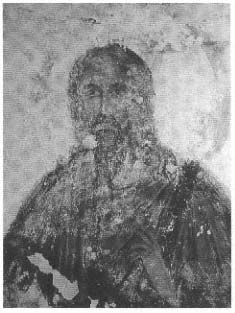
Fig. 163
Detail of a ceiling fresco in the Catacomb
of Saints Marcellino and Pietro in Rome,
showing Christ teaching between Peter
and Paul. Second half of the fourth century A.D.
beard and hair are particularly lush and carefully tended. The high forehead shows no emotion and is emphasized by the central part. Equally consistent is the immaculately draped garment. All of these traits must be intended to banish any possible association with the "filthy" image of the itinerant Cynic philosopher. Instead, the lavish, dense hair emphasizes his magical powers. The painted portrait busts in the catacombs, which have rightly been said to reflect major works of ecclesiastical art, first present us with the fully formed image of Christ in majesty that will so dominate Byzantine art.
In the time of Theodosius, when the bearded Christ on sarcophagi proclaims his law with a magisterial gesture, the old formula has taken
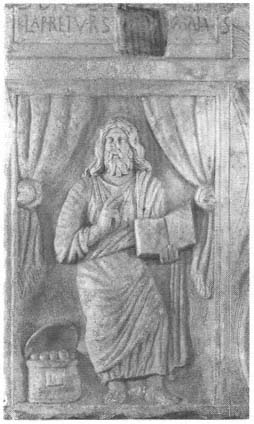
Fig. 164
Strigilated sarcophagus showing Christ as teacher.
Ca. A.D. 370. Rome, Sant'Agnese fuori le mura.
on a new meaning. Yet a more modest strigilated sarcophagus of the same period illustrates how the continuity from the image of the teacher of wisdom has still not been forgotten (fig. 164). As in the earlier scenes with the gathering of pupils, Christ turns directly to the viewer and presents him with the Scripture. The chest of book rolls once again emphasizes the great learning of the teacher. But the
curtains, as in Imperial state art, characterize the site of his epiphany as an impressive public setting. Meanwhile, the lid illustrates that ancient symbol of happiness, the marine thiasos .[54]
At this point we should take at least a brief look at the portraits of the apostles. Typologically they are quite distinct from the image of Christ and are based instead on the traditional repertoire and iconography of the intellectual. Particularly characteristic are the conventional beard, the bald head, and the expression of concentrated thought. The countenance of Christ, by contrast, is free of any sign of exertion.[55] This is also true of Peter and Paul, who early on were set apart from the others in Roman art and received a distinctive physiognomy. Paul is usually bald and/or has a long beard tapering to a point, while Peter has a "classically" styled beard and hair.
Sometimes we may even have the impression that the assimilation of the apostles' iconography to that of the ancient philosophers may have served the artists or their patrons as a means of conveying certain specific messages. Thus, for example, on a well-known ivory pyxis in Berlin (fig. 165), the head of Paul is clearly reminiscent of Socrates, while Peter holds a "Cynic's club" and has the unkempt hair of an itinerant philosopher.[56] Both these visual allusions evoke earlier sets of associations.
Yet in spite of all these ties to the pagan iconography of the intellectual, the imagery of Christ quickly transcends the received tradition. Early Christian art brings about a fundamental change in the depiction of the intellectual and of the workings of the mind. For the first time we are confronted with a clearly defined hierarchy, in which the teacher enjoys absolute authority and the pupils appear fully devoted to him. Furthermore, for the first time the viewer is addressed directly and virtually drawn into the scene. The gathering of teacher and pupils becomes a kind of devotionary image. Not incidentally, from now on the book rolls and codices are displayed in such a way that the viewer is able to read the Holy Writ.
From the beginning there had been a growing tendency in scenes of Christ teaching to portray him as the dominant figure. Although some of the earliest catacomb paintings show Christ on virtually the same
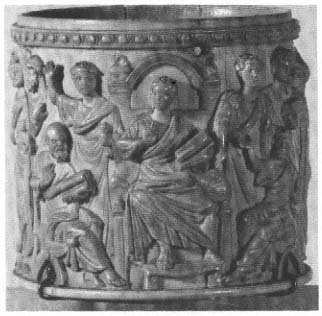
Fig. 165
Ivory pyxis showing Christ enthroned as teacher above
the apostles, with Peter and Paul next to him. After A.D.
400. Berlin, Staatliche Museen.
scale as the disciples, he soon becomes larger and clearly elevated above them. Yet even so, the image of Christ as philosophical teacher was eventually not enough, since it failed to make visible his divine power. Thus from the late Constantinian period, certain elements of Imperial imagery were transferred to Christ, while court theologians and writers of panegyric developed a symbolic system to demonstrate how the power of the emperor is derived from that of God. On the sarcophagus of Junius Bassus, a youthful Christ appears enthroned on the arch of Heaven as kosmokrator, and it is not long before the apostles, imitating Byzantine court ritual, approach him with their hands cloaked, to receive the "law" from the hand of Christ. The viewer is invited to assume the same attitude of reverence. So, for example, on the sarcophagus of Bishop Concordius, two patron figures, representing the
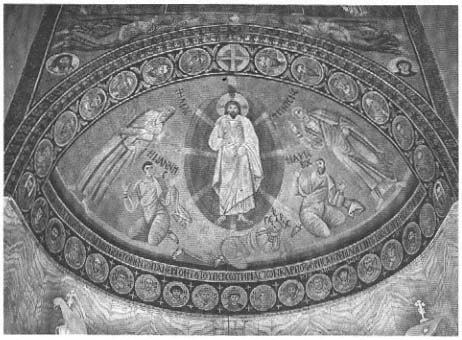
Fig. 166
Mosaic in St. Catherine's in Sinai, showing the transfiguration of Christ. Sixth
century A.D.
populace, are brought before the holy gathering in an appropriately humble pose (fig. 159).[57]
In these hierarchically structured compositions, the artists make good use of the different portrait types of Christ and the apostles in order to give added clarity to the relative ordering of status. Apart from Christ, only the prophets, the evangelists, and a few figures from the Old Testament who enjoyed positions of special authority, such as Abraham and Melchizedek, are depicted with long hair and a full beard. To differentiate them from Christ, they often have grey hair, or their hair and beard are not as carefully styled. Just how rigidly the hierarchy was sometimes observed is illustrated by the splendid mosaic of the transfiguration of Christ in the Monastery of St. Catherine in Sinai (fig. 166).[58] Christ hovers between Elijah and Moses, all three
represented in the portrait type of the "holy man." But whereas the two prophets stand on earth, Christ appears in a mandorla. Of the disciples at his feet and the apostles, saints, and true believers in the tondi, however, many are shown in the traditional iconography of the Greek intellectual.
The Late Antique Philosopher "Look"
The image of Christ as the teacher of wisdom was not simply derived from that of the theios aner; it was in some sense in competition with it. It is, unfortunately, not possible to reconstruct this process of mutual influence in detail, since the body of evidence for Late Antique philosophers is tiny compared with the wealth of representations of Christ and is mostly quite late as well. There are, however, some literary descriptions that present an impressive glimpse into the beliefs and concerns of the philosophers. They show that their mentality was in many respects not so very different from that of contemporary Christians.
Starting in the third century, the popular notion of a philosopher and what was expected of him once again underwent a major change. Eunapius' Lives of contemporary "philosophers and Sophists," written about 400, are fundamentally different from Diogenes Laertius' Lives of the Philosophers or the Lives of the Sophists of Philostratus, both works of the early third century. While both these earlier accounts deal with men who were well integrated into urban society and displayed a whole range of human strengths and weaknesses, Eunapius writes what are basically hagiographies. He presents the reader with a new kind of mental and spiritual superman who despises his mortal body and continually seeks purification in order to be nearer the gods, who even enjoys certain divine powers himself, and whose entire life is surrounded by an aura of the mystic and the sacred. Each one of the Lives is based upon the same catalogue of physical and spiritual qualities that we first met in Pliny's description of Euphrates. But in addition there is a greatly heightened religious dimension to them, manifested in supernatural phenomena, miracles, and prophecies that attest to the
presence of the divine in these men, "priests of the all-encompassing divinity" (Porph. Abst. 2.49). Here, for example, is Eunapius' description of the philosopher Prohairesios: "One could scarcely estimate his size, so much did he exceed all expectation. For he seemed to be nine feet tall, so that he looked like a colossus, even when he stood along-side the tallest of his contemporaries" (VS 487). When Prohairesios was summoned to Gaul by the emperor Constans, many "could not really follow his lectures and thus admire the secrets of his soul. For this reason they clung to what they could see clearly before them, the size and beauty of his body. They looked up to him as to a colossal statue, so much did his appearance outmeasure any human standard" (VS 487, 492).[59] The religious aura is intensified by the repeated references to looking up to a statue. As early as the mid-third century, in a scene from the tomb of the Aurelii in Rome, is a depiction of one of the miraculous wise men, over-life-size, sitting in some public place and instructing the throngs who crowd around him.[60] We are apparently dealing here with a very widespread need, among Christians and non-Christians, educated and uneducated people alike, to believe in an incarnation of the divine, and even the "holy men" themselves could not escape it. Iamblichus, for example, feels compelled to contradict his pupils when they believe that when he is privately at prayer, "his body would rise up ten ells above the earth, and his garment would radiate with a golden beauty" (Eunap. VS 458). When the transfigured Christ appears in the mandorla, he embodies essentially the same visual conception.
With all this, the great philosophers of late antiquity still considered themselves the spiritual heirs to the classical tradition. They sought their philosophical roots above all in certain of the metaphysical writings of Plato, which they had "rediscovered" and "purified." In their daily lives, however, they modeled themselves most closely on Pythagoras, the ascetic, pious, and pure philosopher of Porphyrius' description ( Vit. Pyth. ). Indeed, Philostratus had already turned Apollonius of Tyana into a pure Pythagorean. Starting with Plotinus, this amalgam of Platonic, Pythagorean, and mystical elements was thought to constitute a sacred teaching, which would be passed on within the Neoplatonic school from generation to generation, by one "divine"
(theios ) or "holy" (hieros ) man to the next. Unlike in earlier philosophical schools, contemplation of the divine, oracles, and secret teachings all now played a central role. In the practice of what is called theurgy, associated above all with Iamblichus, the gods themselves intervene directly and raise up the human soul to themselves in a gesture that transcends anv intellectual effort.[61]
But not every worshipper had equal access to this ultimate mystery. The result was a new set of hierarchical structures within the philosophical schools, very different from that of Christianity. The fundamental distinction was between, on the one hand, the traditionally learned philosophers, known as philosophoi or philomatheis ("lovers of learning") and, on the other, those few who had attained the highest form of mystic revelation, the hieratikoi, theioi, or hieroi .[62] These "divine" individuals were above any criticism. Eunapius describes the effect that Maximus of Ephesus, the controversial teacher of Julian the Apostate, had on his pupils: "No one dared contradict him, even the most experienced and verbally skilled of his pupils, on those rare occasions when they dared address him at all. Rather, they listened to him in rapt silence and took in everything he said, as if it had been spoken from the tripod [of Apollo in Delphi]. So sweet and compelling were the words that issued from his lips" (VS 473).
This spirit of subservience to a towering figure of intellectual authority is already reflected on a beautiful philosopher mosaic in Apamea made after ca. 350 (fig. 167). Six of the ancient sages sit on either side of Socrates and listen to his teachings. Although they are still characterized by physiognomic differences, it is only Socrates, elevated like Christ by his central position, who is named by a large inscription. The very man who once cast doubt on the idea of certain knowledge now instructs others ex cathedra . The mosaic was found at Apamea in Syria, the home of a famous Neoplatonic school where Plotinus' pupil Iamblichus, one of the "golden chain of the divine," had taught.[63]
After the triumph of Christianity, the philosophers and rhetoricians lost the tremendous prestige that they had earlier enjoyed in Roman society. Although their ranks continued to be replenished from the urban aristocracies, and they occasionally still held public office, after the failure of Julian the Apostate they quickly became marginalized.
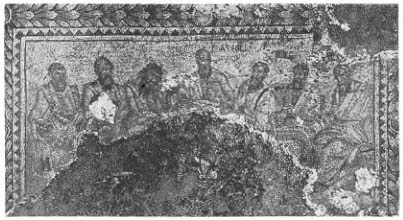
Fig. 167
Mosaic in Apamea in Syria, showing Socrates as the teacher of
philosophers and wise men. A.D. 362/63.
Men of the church now dominated the intellectual field. This is most likely the reason for the very modest number of preserved philosopher portraits from this period.
But in these same circumstances, the pagan philosophers gradually took on a new role. Their schools became repositories of Hellenism in this late phase, places where both classical learning and the cults of the gods were still maintained. It was only natural that, along with their intellectual activities, these late pagan philosophers also served as priests. Proclus (412–485) was still making public sacrifices to Asklepios, even though the emperor Theodosius had ordered the closing of all pagan temples in 391.
Of the few securely identified portraits of philosophers, to which I should now like to turn, it is significant that all of them save one wear the wreath or fillet that is the mark of priestly office. This makes clear how central the priesthoods had become to the identity of these Late Antique philosophers. It may be just an accident of preservation that these portraits all belong to the early fifth century (figs. 168, 170, 171). Typologically they are an astonishingly homogeneous group, even
though they have been found in very different parts of the Empire. All wear a beard and the thick, shoulder-length hair of Christ and the earlier "divine men." Their appearance is consistently elegant, the beard and hair neatly combed and parted, the garment impeccably draped. In contrast to the Christian ascetics, who neglected their outward appearance in the manner of the Cynics, the pagan "holy men" always remained an integral part of urban culture. Their style reflected their mainly aristocratic origins. The finest of the portraits are characterized by a remarkably dramatic facial expression turned upward, a trait not found in portraits of contemporary individuals. This must have a specific meaning, a point to which I shall return presently.
Given the striking similarities of these portraits, one might well question how true to life they can be, especially with respect to the long hair. These can hardly be realistic representations, since it is rather unlikely that all these men of advancing age had consistently luxuriant, full heads of hair. Could it be that the "divine" figures in the philosophical schools wore hieratic wigs or masks, like the earlier priest of Asklepios, Abonuteichos (cf. p. 263)?
The provenance of four of these portraits is known: Athens, Constantinople (Istanbul), Aphrodisias, and Rome. We can therefore assume that this last of the ancient types of intellectual portraiture was spread through the whole of the Empire.[64] The uniformity within the group also leads to the inference that differences among the various philosophical traditions no longer mattered in shaping the identity of the individual. The known provenances echo precisely what Garth Fowden has called the "topography of holiness." For along with the revived Platonic Academy in Athens, the major schools were located in the cities of Asia Minor—Pergamum, Ephesus, Sardis, Aphrodisias—as well as in Apamea in Syria and Alexandria in Egypt. It was in these great centers, which transcended regional boundaries and were closely linked to one another, that classical studies still flourished into the fifth century.
R. R. R. Smith has been able for the first time to reconstruct a specific setting for one of these portraits of an old philosopher, based upon the archaeological context of the recent discovery at Aphrodisias (fig. 168).[65] Together with several other tondo portraits, it decorated an exedra, which, along with a porticus and an apsidal room, was built
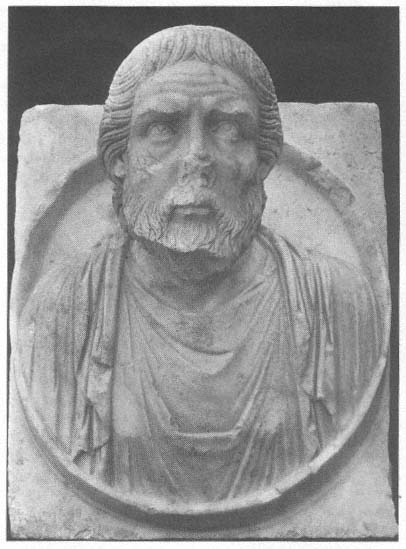
Fig. 168
Tondo from an apsidal hall: portrait of a contemporary philosopher.
Early fifth century A.D. Aphrodisias, Museum.
onto a wealthy residence of the Early Imperial period. The building was situated in the middle of the city, directly behind the well-known Caesareum. Smith adduces good reasons for identifying the complex as the location of the Neoplatonic philosophical school of Aphrodisias, where Asklepiodotus taught in the fifth century. He had studied with Proclus in Athens and later married the daughter of one of the richest citizens of Aphrodisias. The lavish decoration and central location of the school confirm that the philosophers of Aphrodisias still enjoyed public recognition and had access to substantial funds. The tondi, of course, were placed to be visible not from the outside, but rather from inside. That is, they served as inspiration to the teachers and pupils, not as a means of showing off to the public at large.
The preserved portraits and fragments fall into two different series. The one includes heads of ancient poets and philosophers, identified by inscriptions, some shown with their famous pupils (Aristotle with Alexander, Socrates with Alcibiades); also Pindar, Pythagoras, and Apollonius (presumably the one from Tyana). The other group comprises the contemporary philosopher, a beardless, rather youthful pupil, and a third contemporary male portrait, identified by Smith as a "Sophist." The latter two may be identified as members of a local family of honoratiores, who had accommodated the school in their home or been its benefactors in some other way. Unlike the first group, these carry no names inscribed, perhaps a token of modesty. Yet the head of the philosopher is larger than all the other portraits. He must have occupied a key position in the school's hierarchy.
A particularly interesting figure in this context is the so-called Sophist, who is also characterized as an intellectual yet is clearly several notches below the philosopher in status (fig. 169). The receding hairline and closely trimmed beard recall the "learned portraits" of the second century A.D. , which were in turn assimilated to great thinkers of the past (see pp. 225ff.). In contrast to the philosophers, his hair falls only to the nape of the neck, not onto the shoulders. He could also be a member of the school, one whose inferior spiritual rank is expressed through differences in hair and beard.
The whole program of busts of ancient philosophers and poets gives us some insight into the profile of the philosophical school. Classical
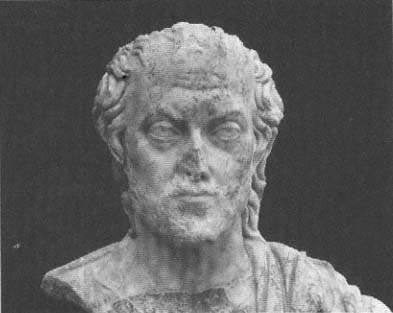
Fig. 169
Portrait of an amateur philosopher (?), from the same series as fig. 168.
Aphrodisias, Museum.
authors still constitute the foundation of its teaching, with the close teacher-pupil relationship highlighted by the famous pairs, that is, as models for the present-day relationship of wise teacher to pupils. The portraits of Pythagoras and Apollonius (Plato must have been in this series too) perhaps represent a particular branch of Late Antique Neoplatonic philosophy. The analogy with the famous teacher-pupil pairs underscores the close relationship between the contemporary philosopher and the beardless youth. Perhaps his parents had entrusted his entire upbringing to this philosopher. Porphyrius, in his Life of Plotinus, records that parents of the noblest families, just before their deaths, would entrust both their children and their fortunes to a philosopher as "divine and holy protector" (Plot. 9).
The visual program of the Aphrodisias school is not a unique instance. Evidence of tondo portraits of classical philosophers and poets
has also been found elsewhere. The choice of those deemed worthy of a portrait varied, but the principle was always the same. The presence of these classical authors was intended to certify the Late Antique philosophers as direct heirs to a long intellectual tradition. In the Early Empire there had already been galleries of portrait tondi in the libraries, representing the veteres scriptores (Tacitus, Annals 2.83). The Christians then adopted the same form of commemoration. Christ appears surrounded by the apostles, saints, and devout patrons, in the same manner as the pagan holy man with his classical authors, more advanced disciples, and boyish pupils.
The wisdom and divine revelation of the philosopher spring from the stores of classical learning. The portraits of the ancient poets and philosophers represent the whole of the Greek tradition, called up in order to confirm the authority of these latest teachers of wisdom. The law of Christ, on the other hand, is founded upon the divine kingdom of the teacher himself. The one series of portraits is retrospective, while the other looks ahead. Christ is the origin of all things, and all lead back to him.
When the original context is lost, it can indeed be difficult in particular instances to distinguish the bust of a holy man from that of Christ in the same schema. Thus, for example, one might at first wonder if the impressive bust in Istanbul (fig. 170) could represent Christ. But in this instance the priest's fillet in the hair suggests instead one of the holy men. A problematic case is the bust of a teacher in Ostia with his right hand in a teaching gesture and a nimbus around his head, done in opus sectile technique (fig. 172).[66] The portrait was found in association with the tondo portrait of a youth in the lavishly decorated marble hall of a patrician house at the Porta Marina. The pairing of what seem to be teacher and pupil must, on the basis of the recent discovery at Aphrodisias, raise doubts about the widely held interpretation of the teacher as Christ. Likewise, two splendid scenes of animal combat with circus lions in much larger format on the same wall argue for a pagan setting. The chamber was abandoned before its completion, ca. A.D. 395. Most likely this was a kind of private philosophical school in the home of a wealthy pagan family, and the animal com-
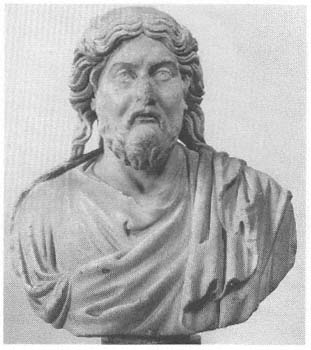
Fig. 170
Bust of a contemporary philosopher. Ca. A.D. 400.
Istanbul, Archaeological Museum.
bats, as on some third-century sarcophagi, allude to the family's public benefaction of sponsoring the games. If this is the case, then the explanation for the interruption of building activity would be different from that proposed by Giovanni Becatti and Russell Meiggs. It was caused by the Christian reaction to the revival of pagan cults, especially under the emperor Eugenius (d. 394).
The usual interpretation of the hall as a gathering place for Christians rests on the identification of the sage as Christ, and this in turn rests largely on the nimbus. But as a representation of light, and hence a symbol of inner strength, this could be an attribute of a wide variety of figures and even finds a direct equivalent in the contemporary image of the "holy man."[67] About A.D. 485 Marinus described the philosopher Proclus thus:
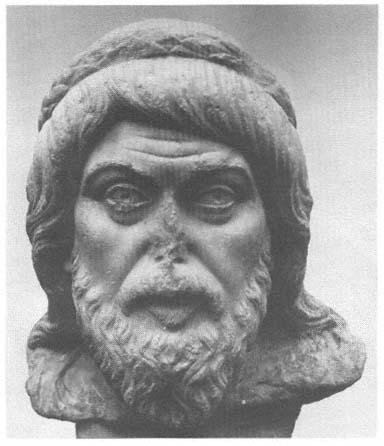
Fig. 171
Philosopher of the early fifth century A.D. Athens, Acropolis Museum.
He seems truly to have enjoyed a particular divine grace. The words issued from the wise man's mouth like snowflakes. His eyes were like lightning bolts, and his whole face was filled with a divine radiance. One day, when a high magistrate named Rufinus, a serious and distinguished man, came to his lecture, he actually saw a light running around Proclus' head. After the lecture he got up, threw himself before him, and bore witness under oath to this divine manifestation.
(Vit. Procl. 23)
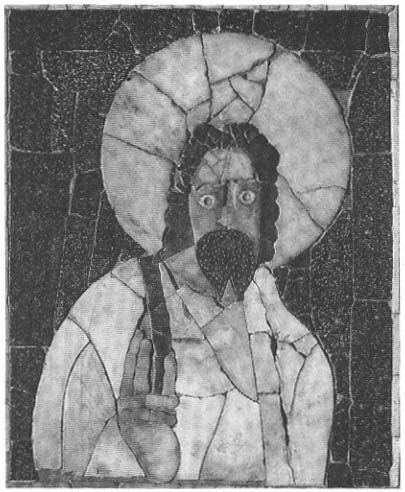
Fig. 172
Opus sectile with the portrait of a Charismatic philosopher (theios aner )
in a nimbus. Ca. A.D. 395. Ostia, Museum.
Porphyrius had already recorded something similar of Plotinus, and in Eunapius' Lives of the philosophers, the gleaming eyes are a standard topos. The eyes of the divinely inspired wise man in Ostia have a particularly intense effect thanks to the colorful intarsia work. The viewer is practically blinded by the dark pupils set amid the big white disk.
In the mysterious rituals of theurgy, which were preceded by fasting, silence, and purification, philosophy became a kind of revelation that surpassed rational thought, a uniting of the soul with the divine. The unusual expressions of the heads in Athens (fig. 171) and Aphrodisias (fig. 168) may be consciously alluding to this mystery. In any case, the sculptors of both works were surely trying to render a state of inner arousal with the head turned upward, the emphatically opened eyes, the brows drawn up, and the lines in the forehead. All these traits are probably meant to convey a readiness for the divine, in expectation of the mystic experience. Everything depended on the degree of one's inner receptivity. As we have seen, the expressions of these "holy men" are entirely different from those of Hellenistic philosophers such as Zeno or Chrysippus (fig. 55), concentrated thinkers whose faces are marked by the will to understand and by the conviction that this can be achieved by dint of their own intellect. The philosopher-priest, by contrast, releases himself, listens expectantly to his inner voice, and turns his spirit into a vessel or a medium.
His expression of longing and of readiness is at the same time profoundly different from the sense of calm and illumination expressed in the portraits of Christ.[68] According to this interpretation, the notion of the "divine" would be represented in the "holy man" in the state of expectation of a higher good, the perfection of his earthly life. But he cannot make this happen, nor can he teach it, for it requires a divine gift that comes to only a few. The portrait in this way expresses something of the curious role of the Late Antique philosophers as élitist outsiders, who saw themselves more and more relegated to the margins of society, even though they usually came from established families and occasionally still served their cities in public office, as Fowden has shown. Christ, however, with his radiant visage, promises the blessings
of divine revelation to all the faithful. This was a message with which the pagan holy man could not compete.
Late Roman Copies: New Faces on Old Friends
Let us look once again at the copies based on earlier portraits of the ancient poets and philosophers. In the fourth century A.D. , cultivated people were still decorating their houses with mosaics and wall paintings that included the famous Greek intellectuals of the distant past. Most popular were Socrates and the Seven Sages, but occasionally there was a broader selection of philosophers, poets, lawgivers, historians, and orators.[69] Even more interesting for our investigation than these examples of traditional decorative arts are the copies of sculptured portrait types. The exedra in the school at Aphrodisias demonstrates that these were still being produced in the fifth century, while copies of other kinds of Greek statuary had almost ceased to be made by the end of the third century. The setting at Aphrodisias explains the continuing interest in the great thinkers of the past. A number of these portraits are of strikingly high quality and attest to a level of skill and commitment on the part of the sculptor that we find elsewhere only in the best portraits of honoratiores .[70]
But what makes the late copies so fascinating is the way the sculptors no longer strive to produce exact copies, as was true earlier, but instead consciously translate the prototype into the visual language of their own epoch. In some cases this is so extreme that we have difficulty identifying a portrait at all. The primary interest was obviously no longer to represent the individual appearance or specific characteristics of each of these great men of the past, but rather to emphasize certain capacities and mental powers that transcend the individual. This process of transformation had already begun in the late third century.
A portrait of Karneades in Bonn, for example (fig. 173),[71] which dates to this period, can still be recognized by the furrowed brow and the turned-down mouth derived from the well-known type (cf. fig. 95). But the immediacy of the expression has been lost. His gaze no longer connects with an interlocutor but is directed upward. The
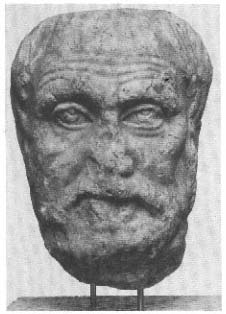
Fig. 173
Carneades. Late Antique version of the Hellenistic
portrait type in figs. 95–96. Late third century A.C.
Bonn, F. J. Dölger Institute.
only expressive element is the eyes themselves, which are proportionally larger and further accented by the powerfully arched brows. In a portrait likewise of the late third century, from Ephesus, Socrates has lost the last vestiges of the silenlike physiognomy (fig. 174).[72] His gaze fixes the viewer. It is perhaps not surprising that a bust of Menander, also from Ephesus (fig. 175), was at first taken to be a portrait of a contemporary of Constantine the Great, so radically has the "copyist" altered the proportions and facial expression.[73] The lines in the face and the gentle and vulnerable expression of the copies in Venice and Copenhagen (cf. figs. 46, 47) have been completely expunged. Instead, we simply stare into the enormous eyes. Compared to the Socrates, the expression is considerably intensified, yet the gaze is no
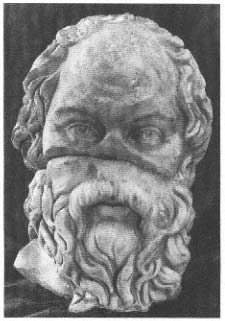
Fig. 174
Socrates. Late Antique version of the Late
Classical portrait type in fig. 35. Ca. A.D. 300.
Selçuk, Museum (from Ephesus).
longer directed at anyone. Instead it conveys an inner illumination that is by now familiar from the images of philosophers. In another portrait of Menander, the tondo formerly at Marbury Hall, this mediating quality of the expression is further heightened by the wide-open mouth.[74] The late portrait of Pindar from the gallery in Aphrodisias (fig. 176) may at first glance seem more faithful. But a comparison with the Late Republican copy in Oslo (cf. fig. 7) reveals that here too the sculptor has modified the original expression of old age and mental strain through alterations to the forehead and eyebrows, in order to create a look of anticipated revelation.[75]
I think these examples will make the point. Despite all the differences in individual detail and the variety of styles in different periods, all these heads are linked through the expression. By emphasizing the
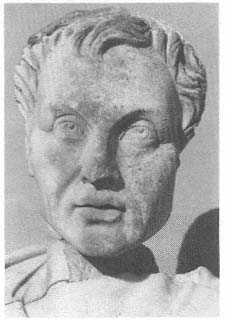
Fig. 175
Menander. Late Antique version of the
Hellenistic portrait type in fig. 47. Constantinian
period. Selçuk, Museum (from Ephesus).
eyes and the forehead the sculptors wanted to convey the notion that these intellectuals of the past were also steeped in the spiritual and the divine. The absence of an individualized face assimilates these portraits to those of contemporary Romans, who often have a very similar expression. But in this way the sense of historical distance that was the basis for the exemplary status of these ancient thinkers is lost.
The process is symptomatic of the age and finds an exact parallel in the use that the Late Antique philosophers and theurgists made of the ancients. Like them, the copyist knew the original (in this case, the portrait, or replicas of it) but kept only as much of the old physiognomy as was necessary for the subject to be recognizable. His true interest was in his own striving for spirituality and mystic revelation,
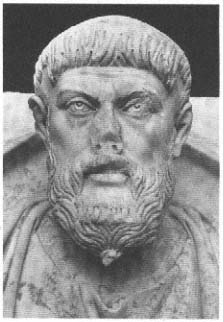
Fig. 176
Pindar. Late Antique version of the Early
Classical portrait type in fig. 7. Early fifth
century A.D. Aphrodisias, Museum.
which he tries to find in the great figures of authority from the past. The ancients are no longer of interest for who they really were, but only as forerunners of contemporary forms of the search for the self. The nature and content of their writings no longer play any part in the shaping of the portrait. Menander is every bit as "spiritual" as Plato or Pythagoras. Whether poet or orator, philosopher or merely a pupil, all of these figures—Homer, Pindar, Socrates, Aeschines, Demosthenes, Alcibiades, Alexander, Apollonius—transform themselves into seekers after God, and in the process their portraits become ever more alike.
Through a lucky chance we have preserved two full-length portraits, of Homer and Plato, in a very rare art form, that will help sup-
port this interpretation. About the year A.D. 370 a flood caused the land around the harbor of Kenchreai to sink into the sea.[76] A whole series of scenes in glass, including gods, mythological figures, donors, landscapes, and several famous Greek thinkers of the past, intended for the windows of a sanctuary of Isis at the harbor, was lost. These precious examples of glass mosaic in opus sectile technique were still in transport containers at the time and were found in the excavations at Kenchreai with their backings stuck to one another. (This explains why the illustration [fig. 177] is reversed.)
The portraits of Homer and Plato have nothing in common with earlier images of these men. Homer has the look of a Late Antique philosopher with long hair that, like Christ's, is parted in the middle (fig. 177). He wears a voluminous mantle; in his left hand he holds a book roll, while the right is raised in the gesture of a teacher. His eyes are open wide and directed at the viewer. Plato, however, looks ahead, his legs and hands drawn together, and contemplates. With his shorter hair receding at the sides, he stands in the same relationship to Homer as the apostles to Christ. The privileging of Homer by iconographical means is remarkable. Apparently the artists and patrons in the sanctuary of Isis considered Homer's authority to be higher than Plato's. If this were a Neoplatonic school, it would no doubt have been the other way around.
The iconographical setting at Kenchreai looks rather conventional. The mythological figures and the landscape scenes recall the earlier association of learning and country life in the ideology of the villa. But, as we have just seen, country life also played an important role for the Late Antique philosopher. Iamblichus, for example, despite his exercises in ascetism, was a wealthy man who owned several villas outside Apamea. But the fact that Homer and Plato are shown larger and more carefully rendered than the other subjects, and that they appear in the costume of the contemporary philosopher, suggests that these icons of classical learning were expected to be more than they had been in the sculptural decoration of the earlier Roman villa. They too have turned into teachers of wisdom.
The number of ancient poets and thinkers whose portraits were still
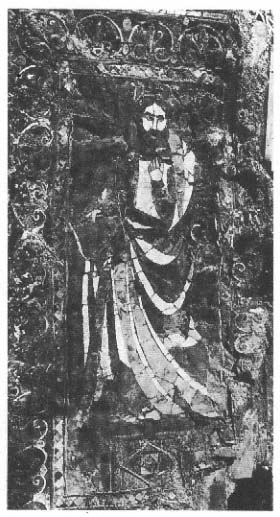
Fig. 177
Homer. Glass window from Kenchreai (reversed). Ca. A.D. 370.
being copied (or, rather, refashioned) in the fourth and fifth centuries is relatively small. Even Julian the Apostate wrote: "We should not concern ourselves with all the philosophers and teachings, but only those who fill us with wisdom and teach us something about God" (Ep. 300d–301a, cf. 301c). Proclus' views, a century later, are much more extreme: "If it were up to me, the only writings of the ancients that would still be read and propagated would be the oracles and the Timaeus [of Plato]" (Marinus Vit. Procl. 38). Fortunately not everyone was so narrow. Particularly in the schools of grammar and rhetoric, which carried on independently of the new religion and numbered Christians among their pupils, the range of interests was broader. So, for example, portraits of Menander still occur in considerable numbers, presumably because his diction was considered to be the perfect embodiment of the purest Attic Greek. Didactic and pedagogical concerns may also explain the late replicas of the portraits of Demosthenes and Aeschines.[77]
The Power of the Muses
The source of all poetry and thought was the Muses, daughters of Zeus and Mnemosyne. From them flowed all knowledge and inspiration. Thus I would like to end this final chapter with a glance at the Muses, and not only to pay them due respect. The fact is, they had never before assumed such a powerful role in the visual arts as they did in the Late Antique. When the thought process itself is directed at divine revelation, then all intellectual activity can be perceived only as a form of divine dispensation or grace. These in turn are transmitted to man by divine creatures, Muses or angels.
In the Hellenistic world, the conception of the intellectual enterprise was informed by the notion of individual will. The figure of the thinker himself, with his energy and concentration, was the focus of attention. This affected the Muses too, for they were sometimes depicted immersed in deep meditation as well. In this process, the mythological relationship of Muse and poet could even be inverted, so
highly prized were the achievements of the creative intellectual. At the opening of the Argonautica, Apollonius invokes the Muses, but only as "servants" of his composition. They are no longer, as for Homer and the early poets, the Muses from whom all song emanates.[78] Similarly, on a well-known Hellenistic votive relief in the Palazzo dei Conservatori in Rome, the Muse looks up to a blind old poet like an adoring schoolgirl to her teacher.[79]
But in the course of the Roman period, the pendulum swung once again in favor of the Muses. Now there is scarcely a poet, philosopher, or scholar who does not appear along with his Muse. But the relationship between the two seems now more direct and personal. This is especially clear on the sarcophagi that show husband and wife as teacher and Muse, seated or standing opposite one another, since here the pairing of intellectual and Muse serves also as a metaphor for conjugal harmony (concordia; cf. fig. 147). The mosaic in Madrid that depicts several intellectuals with their Muses against a villa setting has already been mentioned. The Muses have grown in stature; in some scenes they no longer stand quietly, and their vivid expressions seem to be having a powerful impact on their protégés. On the beautiful diptych in Monza, a poet with shaved head listens with rapt attention to the chords of his kithara-playing Muse. His inspiration comes not from the writings strewn carelessly on the ground, but from the Muse and her song.[80]
A diptych of the fifth century in the Louvre presents the Muses as mighty, elemental forces who literally "come over the poets," dancing and flying like the Angel of the Annunciation (fig. 178). The poets, who simply watch and listen, are reduced to purely passive roles.[81] Meanwhile, the Muses themselves have turned into learned figures: Calliope (or perhaps Clio) reads to her charge from a book roll the words that he is to write down!
The notion of spiritual inspiration that marked Late Hellenism and the Christian belief in the creation of Holy Writ through the agency of celestial powers are in essence the same. And this general picture will obtain well into the Middle Ages: wisdom is a mercy that comes directly from God, transmitted by his messengers. This is vividly

Fig. 178
Ivory diptych showing poets with their Muses. Fifth century A.D. Paris, Louvre.
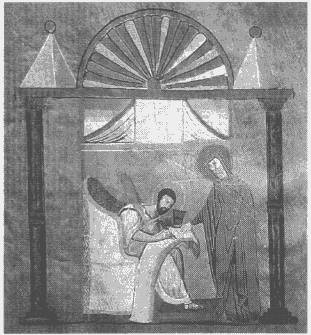
Fig. 179
Illuminated codex: an angel (?) assists Saint Mark in writing
the Gospel. Sixth century A.D. Archepiscopal Library, Rossano.
illustrated in the Rossano Gospels, where a female personification—or is she an angel without wings?—has taken the place of the Muse and dictates word for word to Saint Mark, even going over with her finger and checking what he has just written (fig. 179).[82] The concept of the transmission of knowledge will from now on be dominated by such images of authority. The medieval teacher sits or stands elevated above his pupils and dictates to them. This stereotypical image will long help shape the iconography of the university.[83]
There is a corresponding change in the representation of the book. Instead of a simple attribute that the learned man holds or ponders, it becomes a spiritually charged cultural icon whose power is aimed di-
rectly at the viewer. As in the scenes of teacher and pupils, the image speaks directly to the viewer, and Christ, the saints, and evangelists hold the roll or codex up to him. It makes no difference if the codex is open or only the richly ornamented binding is displayed. Salvation springs from the Holy Scripture, and the assurance of the truth revealed: seeing is believing.[84]